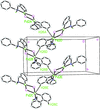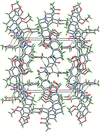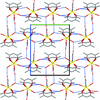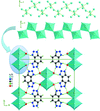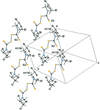issue contents
November 2017 issue

Cover illustration: Four molecular salts made from hexamethylenetetraminium and 2-chloro-4-nitrobenzoate have been synthesized and are reported, namely ammonium hexamethylenetetraminium bis(2-chloro-4-nitrobenzoate), NH4+·C6H13N4+·2C7H3ClNO4-, (I), hexamethylenetetraminium hydrogen bis(2-chloro-4-nitrobenzoate), 0.5C6H13N4+·C7H3.50ClNO4-, (II), hexamethylenetetraminium 2-chloro-4-nitrobenzoate, C6H13N4+·C7H3ClNO4-, (IIIa) and (IIIb). All four molecular salts show N+-H O- hydrogen bonding. Salt (I), illustrated here, crystallized out with an NH4+ counter-ion which came from decomposition of 50% of the hexamethylenetetraminium cation in solution. (II) shows an unusual asymmetric unit, with both a hexamethylenetetraminium cation and a partially deprotonated 2-chloro-4-nitrobenzoate anion. Salts (IIIa) and (IIIb) are polymorphs of each other but have different packing arrangements. This work shows that hexamethylenetetramine only protonates once, even in the presence of excess acid. See: Lemmerer & Motlaung [Acta Cryst. (2017). E73, 1630-1635].
O- hydrogen bonding. Salt (I), illustrated here, crystallized out with an NH4+ counter-ion which came from decomposition of 50% of the hexamethylenetetraminium cation in solution. (II) shows an unusual asymmetric unit, with both a hexamethylenetetraminium cation and a partially deprotonated 2-chloro-4-nitrobenzoate anion. Salts (IIIa) and (IIIb) are polymorphs of each other but have different packing arrangements. This work shows that hexamethylenetetramine only protonates once, even in the presence of excess acid. See: Lemmerer & Motlaung [Acta Cryst. (2017). E73, 1630-1635].
research communications






























































































 journal menu
journal menu














